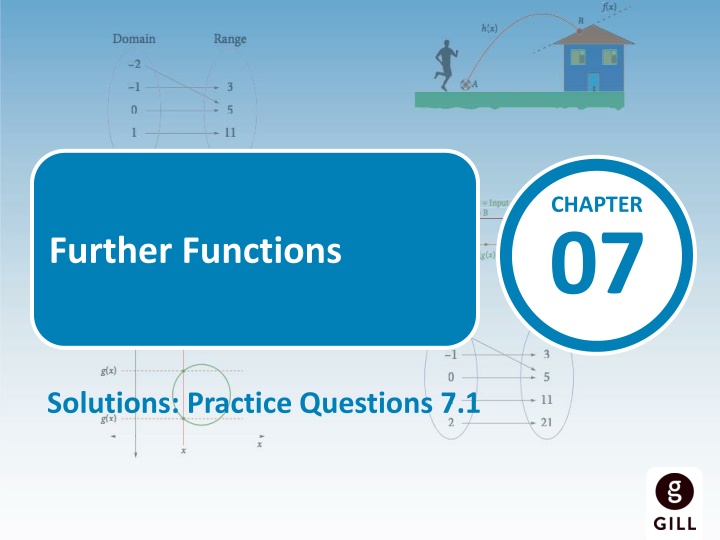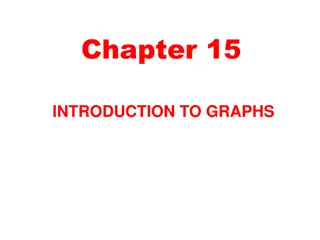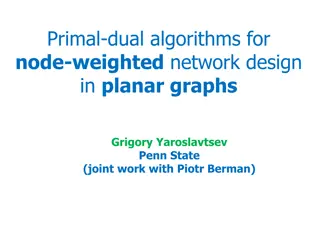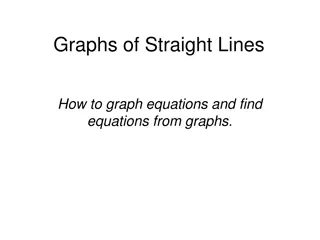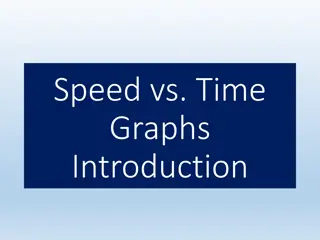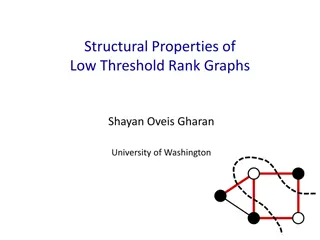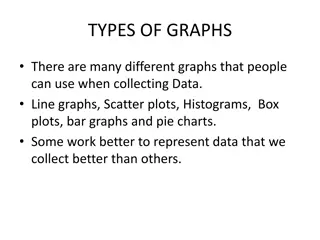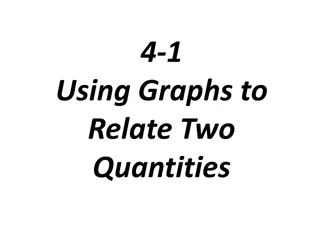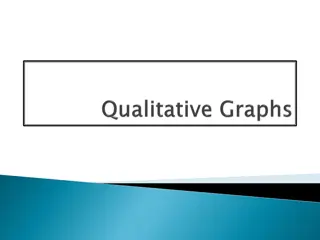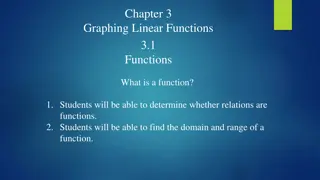Further Functions: Identifying Functions in Mappings and Graphs
Explore how to identify functions in mappings and graphs, understanding the criteria like one arrow leaving each domain element and the vertical line test. Practice questions included to test your knowledge. Evaluate function outputs for different inputs in a given diagram. Enhance your understanding of functions and their representations.
Download Presentation

Please find below an Image/Link to download the presentation.
The content on the website is provided AS IS for your information and personal use only. It may not be sold, licensed, or shared on other websites without obtaining consent from the author.If you encounter any issues during the download, it is possible that the publisher has removed the file from their server.
You are allowed to download the files provided on this website for personal or commercial use, subject to the condition that they are used lawfully. All files are the property of their respective owners.
The content on the website is provided AS IS for your information and personal use only. It may not be sold, licensed, or shared on other websites without obtaining consent from the author.
E N D
Presentation Transcript
CHAPTER 07 Further Functions Solutions: Practice Questions 7.1
07 Practice Questions 7.1 1. Identify which of the following mappings and graphs represent functions. Give a reason for your answer in each case. (i) This is a function as there is one arrow only leaving each element in the domain.
07 Practice Questions 7.1 1. Identify which of the following mappings and graphs represent functions. Give a reason for your answer in each case. (ii) This is a function as there is one arrow only leaving each element in the domain.
07 Practice Questions 7.1 1. Identify which of the following mappings and graphs represent functions. Give a reason for your answer in each case. (iii) Not a function as a vertical line will pass through the graph, more than once, in some places.
07 Practice Questions 7.1 1. Identify which of the following mappings and graphs represent functions. Give a reason for your answer in each case. (iv) This is a function as a vertical line will, at most, pass through the graph once.
07 Practice Questions 7.1 1. Identify which of the following mappings and graphs represent functions. Give a reason for your answer in each case. (v) Not a function as there are two arrows leaving the number 1 and 1.
07 Practice Questions 7.1 1. Identify which of the following mappings and graphs represent functions. Give a reason for your answer in each case. (vi) Not a function as a vertical line will pass through the graph more than once, in some places.
07 Practice Questions 7.1 2. The diagram shows a function, f. Evaluate the output for each of the following inputs: 3, 1, 0, 4, 6, 7 Inputs 2(Input) 4 Outputs 3 1 0 4 6 7 2( 3) 4 = 6 4 2( 1) 4 = 2 4 2(0) 4 = 0 4 2(4) 4 = 8 4 2(6) 4 = 12 4 2(7) 4 = 14 4 10 6 4 4 8 10
07 Practice Questions 7.1 3. The diagram shows a function, ?. Evaluate the output for each of the following inputs: 6, 3, 1, 0, 2, 4, 5 Input 6 3 1 0 2 4 5 (Input)2 + 2 (6)2 + 2 = 36 + 2 (3)2 + 2 = 9 + 2 (1)2 + 2 = 1 + 2 (0)2 + 2 = 0 + 2 ( 2)2 + 2 = 4 + 2 ( 4)2 + 2 = 16 + 2 ( 5)2 + 2 = 25 + 2 Output 38 11 3 2 6 18 27
07 Practice Questions 7.1 4. The diagram shows a function, h. Write down the output for each of the following inputs: A, B, C, D, E, F, G, H, I, J
07 Practice Questions 7.1 5. A function is defined as follows: 1, when x is odd 3, when x is even f (x)= ,where x N Find: (i) (d) f (4) (a) f (1) f (4) = 3 (Input even) f (1) = 1 (Input odd) (b) f (2) (e) f (5) f (2) = 3 (Input even) f (5) = 1 (Input odd) (c) f (3) f (3) = 1 (Input odd)
07 Practice Questions 7.1 5. A function is defined as follows: 1, when is odd 3, when is even x x = ( ) f x ,where x Represent these couples on a graph. (ii) Note: We do not join the points as the function is only for x .
07 Practice Questions 7.1 6. A function is defined as follows: h(x) = 7 x Find: (i) h(2) (iv) h( 3) h(2) = 7 2 = 5 h( 3) = 7 ( 3) = 10 (ii) h(5) (v) h( 4) h(5) = 7 5 = 2 h( 4) = 7 ( 4) = 11 (iii) h(10) h(10) = 7 10 = 3
07 Practice Questions 7.1 6. A function is defined as follows: h(x) = 7 x Find: (vi) the value of x for which h(x) = 18. h(x) = 18 h(x) = 7 x 18 = 7 x x = 7 18 x = 11
07 Practice Questions 7.1 7. The following mappings represent functions. In each case: (i) complete the mapping Function output = 4 (Input) 2 (a) Input = 3: output = 4( 3) 2 14 3 = 12 2 = 14 6 1 Input = 1: output = 4( 1) 2 10 = 4 2 5 = 6 Domain (Inputs) Range (Outputs)
07 Practice Questions 7.1 7. The following mappings represent functions. In each case: (i) complete the mapping Function output = 4 (Input) 2 (a) Output = 10: 10 = 4(input) 2 14 3 10 + 2 = 4(input) 12 = 4(input) 6 1 3 = input 10 3 Input = 5: output = 4(5) 2 18 5 = 20 2 = 18 Domain (Inputs) Range (Outputs)
07 Practice Questions 7.1 7. The following mappings represent functions. In each case: (ii) list the set of ordered pairs Function output = 4 (Input) 2 (a) {( 3, 14), ( 1, 6), (3, 10), (5, 18)} 14 3 6 1 (iii) write out the domain Domain is the set of input values:{ 3, 1, 3, 5} 10 3 18 5 (iv) write out the range. Domain (Inputs) Range (Outputs) Range is the set of output values:{ 14, 6, 10, 18}
07 Practice Questions 7.1 7. The following mappings represent functions. In each case: Function: output = 5 2(input) (i) complete the mapping (b) Input = 2: output = 5 2( 2) 9 2 = 5 + 4 = 9 7 1 3 Input = 1: output = 5 2( 1) 6 = 5 + 2 = 7 Domain (Inputs) Range (Outputs)
07 Practice Questions 7.1 7. The following mappings represent functions. In each case: Function: output = 5 2(input) (i) complete the mapping (b) Output = 3: 3 = 5 2(input) 9 2 3 5 = 2(input) 8 = 2(input) 7 1 4 = input 4 3 7 6 Input = 6: output = 5 2(6) = 5 12 Domain (Inputs) Range (Outputs) = 7
07 Practice Questions 7.1 7. The following mappings represent functions. In each case: Function: output = 5 2(input) (ii) list the set of ordered pairs (b) {( 2, 9), ( 1, 7), (4, 3), (6, 7)} 9 2 (iii) write out the domain 7 1 Domain is the set of input values:{ 2, 1, 4, 6} 4 3 7 6 (iv) write out the range. Range is the set of output values:{ 7, 3, 7, 9} Domain (Inputs) Range (Outputs)
07 Practice Questions 7.1 8. The diagram shows a section of the graph of the function ? (?). Use the graph to evaluate the following: f ( 1) (i) f( 1) = 3 f (2) (ii) f (2) = 3 The value of x for which f (x) = 2 (iii) Go to 2 on the y-axis Draw a line across until you touch the graph. Draw a line down until you touch the x-axis. x= 1 5
07 Practice Questions 7.1 8. The diagram shows a section of the graph of the function ? (?). Use the graph to evaluate the following: Using your answers to parts (i) (iii), or otherwise, write out the rule which the f (x) function is applying. (iv) Notice that each output is one less than twice the input. Output = 2(Input) 1 f (x) = 2x 1
07 Practice Questions 7.1 9. f (x) = x2 + 1 The diagram shows a blank mapping for the function: Copy this mapping and complete it by adding in arrows from the inputs to the outputs, as appropriate. (i) x2 + 1 Input Output 2 ( 2)2 + 1 = 4 + 1 5 1 ( 1)2 + 1 = + 1 2 0 (0)2 + 1 = 0 + 1 1 1 (1)2 + 1 = 1 + 1 2 2 (2)2 + 1 = 4 + 1 5
07 Practice Questions 7.1 9. f (x) = x2 + 1 The diagram shows a blank mapping for the function: Write out the domain. (ii) Domain is the set of input values: { 2, 1, 0, 1, 2} Write out the range. (iii) Range is the set of output values: {1, 2, 5} Write out the co-domain. (iv) Co-domain is the set of all possible outputs: {0, 1, 2, 3, 4, 5, 6}
